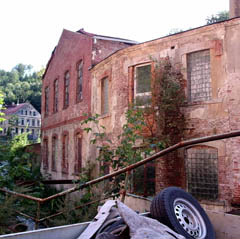
The Liberec Region has published an overview of abandoned factories and buildings
 |
The mapping of unused properties was carried out in cooperation with the CzechInvest Agency for Business and Investment Support. According to Michael Otta, head of the regional development department, the study included sites larger than half a hectare or built-up areas exceeding 250 square meters.
In total, experts identified 364 properties, and the region will prepare more detailed studies for 200 of them. Only for the revitalization of areas larger than two hectares or built-up areas above 500 square meters will it be possible to draw funding from the Operational Program for Business and Innovation, which will have 16 billion Czech crowns available from 2007 to 2013. Support can also be obtained from the Operational Programs for the Environment or Rural Renewal.
A brownfield is a land or property that is not being effectively utilized, is neglected, and in many cases, is contaminated. The property cannot be used without revitalization, which often represents costs on the order of tens or even hundreds of millions of Czech crowns. The highest number of unused areas in the Liberec Region is in the Frýdlant Region and also in the Česká Lípa and Novoborsko areas. These are not just abandoned industrial or agricultural sites, but also monuments, apartment buildings, and properties that have never been completed. However, the most prevalent are abandoned textile factories and former glassworks.
Experts have so far prepared more detailed materials with proposals for use, for example, for the castle in Horní Police in the Česká Lípa region, where according to the study, a multifunctional complex with a community hall, library, and space for various leisure activities could be created. In the former Tofa in Semily, there are plans for smaller production or civic amenities. Revitalization projects are also prepared for the former Research Institute in Břehyně near Doksy, the former Unitex site in Jindřichovice under Smrk, Textilan in Nové Město under Smrk, or the former piano factory in Liberec-Kateřinky. The former glassworks in Svor in the Česká Lípa region, the unused porcelain factory in Desná, or the Seby T plant in Velké Hamry in the Jablonec area, as well as the Hybler textile factory in Přepeře could also receive new uses. Revitalization of these would require an estimated 1.2 billion Czech crowns.
The high costs of restoration are one of the reasons why there is little interest in such properties. "The costs of restoring these properties are often much higher than building new ones on greenfield sites," said Kateřina Lorencová from CzechInvest to ČTK. Therefore, the agency, in cooperation with the regions, is preparing a project to revitalize about 3,000 such sites throughout the country. In the past, according to Lorencová, money has been successfully obtained for the restoration of neglected sites. "In recent years, about 580 million Czech crowns went into the restoration of brownfields, and 48 properties have been revitalized, including, for example, the Škoda Plzeň site or the airport in Žatec," she added. Successful examples can also be found in the Liberec Region - such as the Babylon Entertainment Center in Liberec, which was created from the former Hedva textile factory, or the former Kolory plant, which was converted into a foundry and machine shop by the Beneš and Lát company.
The English translation is powered by AI tool. Switch to Czech to view the original text source.
0 comments
add comment










